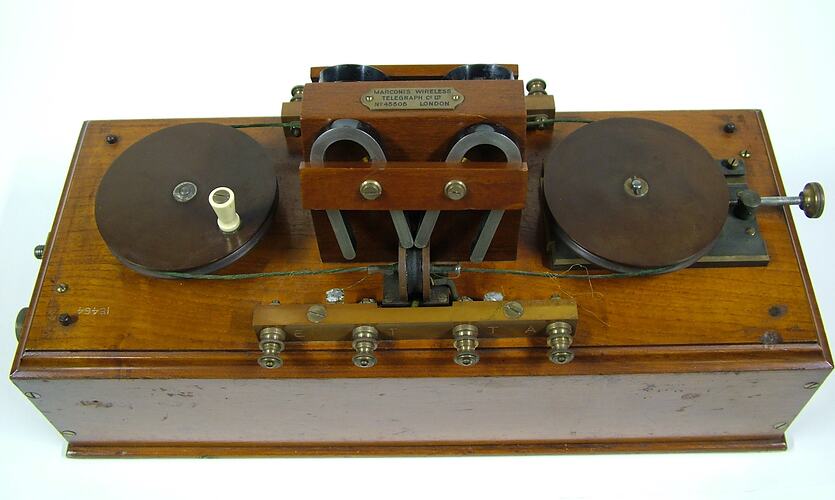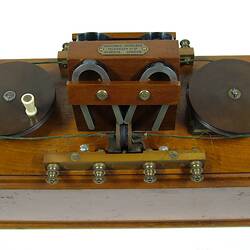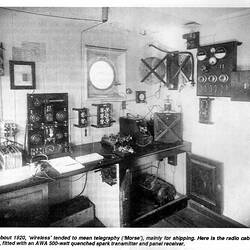Summary
Magnetic detector, double coil type, made by the Marconi Wireless Telegraph Company. The device has two detectors, one on each side.
It was used as one way to detect radio signals in radio receivers prior to the development of the electronic valve. A receiver would consist of the detector and a multiple tuner such as ST 015459.
The other ways of detection were to use a coherer or a crystal detector. The magnetic detector was more sensitive than a coherer but less sensitive than a crystal detector. However, it was far less affected by vibration so it was the preferred detector for use on ships during the 'spark' era (1894 - circa 1919).
Each detector operates as follows: a clockwork motor inside the base drives a loop of multistranded cable of soft iron wire. The wire passes through a glass tube around which is a small inner coil and large outer coil of wire. A pair of horseshoe magnets are placed so that the magnetisation of the moving cable reverses at the centre of the two coils. The radio frequency signal to be detected is selected by the tuner and applied to the inner coil via the terminals marked 'A' and 'E'. A pair of headphones (missing) is connected to the outer coil via two terminals each marked 'T'.
The moving cable services both detectors and the clockwork motor is wound by a handle, such as ST 15464.3 or HT 33722.
Physical Description
Wooden box with pair of pulleys carrying a metal cable, which passes through glass tubes on each side; each glass tube is surrounded by two coaxial coils. In the centre is a wooden block carrying a pair of horseshoe magnets on each side. Each set of coils is connected to a block containing four terminals. One pully has a knob for hand winding. The other pulley is mounted on a slide with an adjusting screw to allow the cable to be tensioned. One one side of the box is screw fitting for a winding handle and a start/stop knob. A removable box with glass top covers the mechanism. Winding handle: tubular stepped metal cylinder with internal thread at one end and T handle at the other.
Significance
The equipment is typical of early shipboard radio in the period prior to the First World War (1914 - 1918); it is rare.
More Information
-
Collecting Areas
-
Acquisition Information
Donation from Amalgamated Wireless (Australasia) Ltd., 29 Dec 1924
-
Manufacturer
-
Inscriptions
Brass plate on top: MARCONI'S WIRELESS / TELEGRAPH Co. Ltd. / No. 45505 LONDON On each terminal block: E T T A Stamped into underside of base: 45505 Paper label inside removable cover: COVER FOR MARCONI WIRELESS / MAGNETIC DETECTOR No 15464 Stamped into lower edge of box: 45505
-
Brand Names
-
Classification
-
Category
-
Discipline
-
Type of item
-
Overall Dimensions
485 mm (Length), 210 mm (Width), 280 mm (Height)
Overall Dimensions - WIth Cover
-
Other Dimensions
482 mm (Width), 207 mm (Depth), 270 mm (Height)
-
References
[Book] Jensen, Peter. 1994. In Marconi's Footsteps, 1894 - 1920., 1994, 100 Pages
-
Keywords



